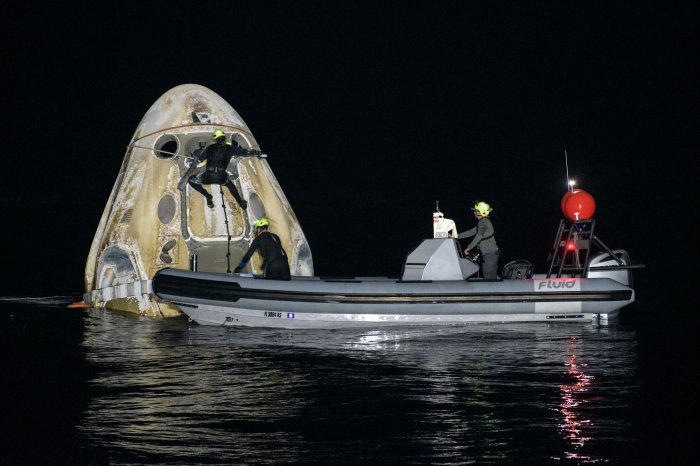1 of 5 | NASA has selected SpaceX's Starship moon and Mars rocket, two of which are shown at the company's Texas plant in February, as a lunar landing system. Photo by Elon Musk/SpaceX |
License Photo
ORLANDO, Fla., April 16 (UPI) -- Elon Musk's SpaceX has won a $2.9 billion contract to develop the company's Starship rocket as a lunar lander and carry astronauts on Artemis moon missions, NASA announced Friday.
In selecting only SpaceX for the lunar program, NASA ended consideration of Musk's rival, Amazon founder Jeff Bezos and his Blue Origin space company, and a third proposal by Huntsville, Ala.-based Dynetics.
The award cements SpaceX's role as the dominant company in a new era of space exploration. The decision also clarifies how NASA plans to accomplish new lunar missions -- using the shiny stainless steel Starship as a spacecraft and lander rolled into one reusable vehicle.
NASA had planned to send people to the moon by 2024, but agency officials have acknowledged that timeline wasn't possible because Congress hadn't provided adequate funding for the human lander system.
NASA sought over $4 billion the last two years to fund lunar landers, but received only about $1.45 billion.
That doesn't necessarily mean astronauts won't set foot on the moon by 2024, acting NASA Administrator Steve Jurczyk said in a press conference Friday at Kennedy Space Center.
"The NASA team will have insight into the progress that SpaceX is making, and if they're hitting their milestones, we may still have a shot at 2024," Jurczyk said.
In the next few years, NASA will require SpaceX to conduct a demonstration flight and landing on the moon, NASA officials said.
Eventually, SpaceX would meet NASA's Orion capsule, which would be launched on NASA's SLS moon rocket, in orbit around the moon. NASA didn't require a launch location for SpaceX's Starship.
NASA still hopes others will provide landers in the future, said Kathy Leuders, associate administrator for the agency's human exploration programs.
"It was in NASA's best interest, along with ... the budget that was there for us to award to one demonstration mission at this time," Leuders said. "And then begin discussions with industry about how to further develop additional competition out there."
She said that no lander will fly until it is proven safe.
Starship provided benefits the other two landers don't have, said Lisa Watson-Morgan, program manager for the human landing system.
"Starship includes a spacious cabin, and two airlocks with a great deal of space for our crew, as well as additional payload capability," Watson-Morgan said. "That will permit us to take experiments to the moon and return samples back and do all the important science that we want to do on this mission."
Starship would be the first spacecraft to land people on another planetary body without an ascent module that can take off and leave the lander on the surface. Apollo missions were designed with ascent modules in case the landing damaged the bottom of the lander.
"The solutions may look different," Watson-Morgan said when asked about the lack of an ascent module. "We did not have a concern there."
Starship, at 160 feet high, is designed to be capable of launching capsules. For deep space missions, however, it would be stacked on an even larger booster -- the Super Heavy.
SpaceX has flown Starship prototypes four times at the company's spaceport in Boca Chica, Texas, about 180 miles south of Corpus Christi. But all four flights were followed by explosions either upon landing, just after landing or just before landing.
NASA had awarded almost $1 billion to all three space companies to develop ideas for the lander, and the space agency had said it may choose two of the proposals.
Support teams work around the SpaceX Crew Dragon Resilience spacecraft shortly after it landed with NASA astronauts Mike Hopkins, Shannon Walker and Victor Glover and Japan Aerospace Exploration Agency astronaut Soichi Noguchi aboard in the Gulf of Mexico off Panama City, Fla., on Sunday. Photo by Bill Ingalls/NASA |
License Photo
















